Tags
Harsiddhi Temple, India Travel, Jyotirlinga, King Vikramaditya, Lord Shiva, Madhya Pradesh, Mahakaleshwar Temple, Planet Mars, Prime Meridian, Shakti Peeth, Simhastha Kumbh Mela, Ujjain
Hey Guys 🙂 Welcome to my first post of 2017. Hoping that this new year has been wonderful to you so far, I wish you all love, health, happiness, knowledge, peace and prosperity for the future. Cheers 🙂
Today’s post is the continuation of my Amazing Madhya Pradesh series. If you’re visiting me for the first time, I would suggest going through my previous posts in this series. Here are the links:
Madhya Pradesh, The Heart of Incredible India
Amazing Madhya Pradesh (Part I): Indore
In this post, I will take you to the ancient city of Ujjain. I had visited this sacred and spiritual place in April 2015 on a day trip from Indore. Enjoy my story 🙂
A bit about Ujjain…
Ujjain is located 55 KM from Indore in the Malwa region of the central Indian state of Madhya Pradesh. Ancient temples form an integral part of this city and continue its tradition of greatness. Desecrated time and again by Muslim invaders, the structures that stand today are of a more recent date, renovated or rebuilt over the years.
This ancient city is situated on the eastern bank of the sacred river Kshipra (or Shipra), the site of the grand Hindu spiritual festival – the Simhastha Kumbh Mela, which takes place once in twelve years in the Hindu calendar month of Chaitra (March–April). A celebration of faith in divinity and spiritual awakening which sees millions of devotees, including saints and monks across the country taking a dip in the holy Kshipra, the only river that travels straight from South to North. It is believed that by bathing in this river, one is blessed with divine energy. Offering prayers to the city’s presiding deity – Lord Shiva, meditation, attending discourses and sermons, reciting scriptures, chanting of hymns from holy books, serving the monks and the poor, observing fasts and practising spiritual discipline assume importance during the time period spanning from Chaitra Poornima (Full Moon in March-April) to Vaishakh Poornima (Full Moon in April-May). Ram Ghat is where millions of pilgrims gather during this event. The aarti here is renowned and the ghat is known to be the oldest bathing ghat in Ujjain. Devotees visit the Ram Ghat all year round for the ritual bath to wash away their sins.
Ujjain is an important place for major religious activities and is mentioned in ancient Hindu scriptures. It is one of Sapta Puris, the seven most revered pilgrimage centres of India, and home to the famous Mahakaleshwar Temple (also known as Mahakal), which enshrines one of the twelve Jyotirlingas (the sacred abodes of Lord Shiva). Moreover, it is situated on the line of Tropic of Cancer, and has greater importance compared to other holy cities of India because of its unique geographical position for calculation of time.
Ancient scholars considered Ujjain as the prime meridian (or zero longitude). The tilting of earth at an angle of 23.5 degrees on its axis and the line of Tropic of Cancer has a special cosmic influence, making Ujjain an ideal place for time calculation and creation of Panchang (Hindu calendar). Thus, this city situated on the intersection of the Tropic of Cancer and the meridian is also known as ‘Greenwich of India’. ‘Time’ in Sanskrit is called ‘kal’. Hence Shiva is worshipped as Mahakal, the God of Time. According to legend, Lord Mahakaleshwar’s idol is situated at the intersection point of the tropic of cancer and the meridian, and it is in the centre of the Earth.
Indian astro-sciences regard Ujjain as central reference point. It has been the main centre of astrology since ancient times. The day used by ancient Indian astronomers began at sunrise at the prime meridian of Ujjain. The ancient Hindu book on astronomy, Surya Siddhanta, which postulated a spherical earth, long before the western world did, explained the prime meridian as passing through Avanti, the ancient name for Ujjain.
Discovering Ujjain…
From Indore, buses – standard as well as luxury – depart for Ujjain every ten minutes. It is an hour-and-a-half-long journey. The bus ticket costs 55 rupees.
Reaching Ujjain, my first destination was the Mahakaleshwar Temple, located in the heart of the city. From the bus station, I took a shared auto-rickshaw, and thereafter another. Each at five rupees only!
Shared auto-rickshaws…
Mahakaleshwar Temple
The origins of the Mahakaleshwar Temple are not known but earliest references to the Mahakal date back to the 6th century BC. The temple structure was built by different ruling kings. It was renovated in 11th century AD by the ruler of Paramar dynasty. During 1234-35 AD, Sultan Iltutmish of Delhi attacked Ujjain and knocked down the temple. Over the centuries, the temple faced destruction, reconstruction and renovation. In the 19th century, the last ruling dynasty of the region, the Scindias, took over the temple’s restoration work. In 1948, the princely state of the Scindias merged with Independent India.
The present five-level temple, situated near the Rudra Sagar lake, was reconstructed in 18th century AD. It is a mix of the Paramara, Chalukya and Maratha styles of architecture. The underground level houses the garbhagriha (sanctum sanctorum). The presiding deity, Shiva in the lingam form, is believed to be swayambhu, deriving currents of power from within itself as against the other images and lingams that are ritually established and invested with mantra-shakti. Mahakaleshwar’s idol is said to be dakshinamurti, i.e. facing the south. This is a distinctive characteristic endorsed by tantric traditions, visible only at this jyotirling. Within the temple complex, there is a kunda (reservoir), which is considered holy.
The most important and unique pooja at Mahakaleshwar temple is the Bhasma Aarti, which takes place at 4 AM every day. At this ceremony, bhasm (ash) brought from the crematorium is applied on the lingam of Lord Mahakaleshwar. It is nature’s law that for every death, there is a new birth. So at this jyotirling, Mahakal is the Lord of Earth and Lord of Death as well. The lingam is bathed ritually and worshipped with different kinds of offerings special to the Lord, including bhaang (prepared with leaves and flowers of Cannabis plant).
On Mahashivaratri (the Great Night of Shiva), a major festival celebrated in honour of the god Shiva in February/March, a huge fair is held near the temple, and worship goes on through the night.
Watch my video: Mahakaal Temple
When I arrived at the temple, it was noon. Blistering hot. To gain quick access to the garbhagriha, I paid for a special entrance ticket of 150 rupees. Still, there were quite a many people in the queue. The narrow underground passage crammed with chanting devotees was a claustrophobic experience. The marble floor was wet and slippery. I had a good glimpse of the deity thanks to a kind and helpful priest, who let me stay for a moment longer than others in the garbhagriha. Exiting the temple, I faced a first-time experience. The exit that I took was a bit away from the locker room, where I had deposited my handbag and footwear. When I stepped out, the ground felt so scalding hot beneath my bare feet that I had to run for my life. My feet had become sore but I couldn’t stop. It was awful. I don’t ever remember sprinting so fast and far, bare foot. And everywhere around me people were walking barefoot as if they were in a garden. Luckily, I was carrying a soothing antiseptic cream. At the next temple, I massaged it on my burning feet and felt better.
It was so very, very boiling hot! As per Vedic traditions, the Sun is exactly above Ujjain from March 21.
A thirsty young elephant…
I took an auto-rickshaw tour of other ancient sacred spots of the city. The tour costing 800 rupees lasted for seven hours. These are the places that I visited…
Ujjain was the capital of Vikramaditya, the legendary emperor of ancient India, who is characterised as the ideal king, known for his wisdom, valour, magnanimity and patronage of scholars. He is also considered to be a partly historical figure or a purely mythical character, who in 57 BC, founded the Vikram Samvat calendar, a Hindu calendar which is used in Nepal and some Indian States. Many Indian rulers took him as ideal and kept his name as their title. Many places around the city carry his name.
A temple dedicated to him…
And his throne known as the ‘Seat of Judgement’…
One of the city’s attractions, Bhartrihari Caves, which are natural caves existing since ancient times, are named after the step-brother of King Vikramaditya. Bhartrihari is believed to have lived and meditated here after renouncing worldly life.
Harsiddhi Temple
It is believed that King Vikramaditya was a great devotee of Harsidhhi Mata. The Harsiddhi Temple is one of the most famous shakti peeths (the sacred abode of goddesses of Hindu pantheon) of the country. The temple houses the idols of Mahalakshmi, the Goddess of Wealth, Fortune and Prosperity; Mahasaraswati, the Goddess of Knowledge, Music and Arts; and the famous dark vermilion image of Annapurna, the Goddess of Nourishment seated between them. The symbol of power or shakti, the Sri Yantra, or nine triangles that represent nine names of Durga, the Goddess of Power and Strength, is also enshrined in the temple. The temple was reconstructed during the Maratha period. Within the temple complex, there are two tall deep-stambhs (towers for placing earthen lamps, a special feature of Maratha architecture), that are lit with hundreds of lamps during festivities, especially during Navratri festival.
Bade Ganesh Temple
A few metres away from the Mahakaleshwar temple is the Bade Ganesh Temple, dedicated to Lord Ganesha, the elephant-headed God of Wisdom and Prosperity and the son of Lord Shiva. The huge ornate idol of Lord Ganesha…
The elephant head of the deity signifies wisdom, prudence and foresight. This Ganesha temple is also an important centre of learning of astrology and Sanskrit language. In the ancient Vedic period, around 1500 BC, houses of prayer were study centres too. This practice is prevalent even today in the South Indian temple complexes where idols are worshipped and religious teachings are imparted.
This is the country’s only temple that has a panchmukhi (five-faced) idol of the monkey-god Lord Hanuman which symbolises courage, loyalty, devotion, strength, and righteousness.
Char Dham Temple
This recent temple is popular as it provides devotees with a feeling of having visited all the four Chardhams – Badrinath, Kedarnath, Gangotri and Yamunotri.
Observatory (Vedh Shala)
Taking into account the unique geographical location of Ujjain for calculation of time, this observatory was built by Maharaja Jai Singh II between 1725 AD and 1730 AD. There are five main instruments that study the motions and orbits of the planets.
Sun Dial…
Nadi Valay Yantra…
Transit Instrument…
This is the only observatory among the five observatories built by Maharaja Jai Singh II, where masonic instruments are still used for astronomical studies. The other four include the Jantar Mantar of Jaipur, Delhi, Mathura and Varanasi.
In 1923, the observatory was renovated by Maharaja Madhav Rao Scindia, the then ruler of the erstwhile princely state of Gwalior. Astronomical studies of the planetary motions are still conducted in this observatory and an ephemeris (journal showing daily speed and position of planets) is published annually.
Navagraha Triveni (Shani Temple)
Situated on the Triveni Ghat of the Shipra, this temple is dedicated to Navagraha – the nine (nava) major celestial bodies (grahas) of Hindu astronomy: Surya (Sun), Chandra (Moon), Chevvai/Mangal (Mars), Budhan (Mercury), Guru/Brihaspati (Jupiter), Shukra (Venus), Shani (Saturn), Rahu (North Lunar Node) and Ketu (South Lunar Node). It attracts large crowds on new moon days falling on Saturdays.
Chintaman Ganesh Temple
Built across the Kshipra river, the Chintaman Ganesh Temple is an ancient shrine with artistically-carved 11th-century pillars in the assembly hall.
The Ganesh idol enshrined here is supposed to be swayambhu (deriving currents of power from within itself as against the other images that are ritually established and invested with mantra-shakti). Riddhi and Siddhi, the consorts of Lord Ganesha, are seated on either side of him.
Wednesday is believed to be the ruling day for Lord Ganesh, so devotees throng to this temple on that day to seek the blessings of the Lord, who is ‘the assurer of freedom from worldly anxieties’.
Gadhkalika Temple
The Gadhkalika Temple is another shakti peeth (the sacred abode of Goddesses of Hindu pantheon) site of Ujjain, 2 miles (KM) from the city. The presiding deity is Gadkalika Devi, whose idol is saffron in colour unlike the usual idols of Goddess Kalika which are black in colour.
This ancient temple was renovated in 7th century AD by Emperor Harshvardhan. The legend goes that the famous Classical Sanskrit writer Kalidasa used to visit this temple regularly. Because of his great devotion to the goddess, he was blessed with supreme literary skill.
The present structure was built by the rulers of the Scindia dynasty.
Sandipani Ashram
Apart from its religious and political importance, ancient Ujjain was a seat of great learning and the oldest centre of education. It gained greater academic prominence than Kashi (Benares or Varanasi) and Nalanda.
Sandipani Ashram, located 2 KM from the city, is a place of great mythological value. It is named after Maharishi Sandipani, the Guru (Master) of Lord Krishna. It is believed that Lord Krishna received his early education here along with elder brother Balram and friend Sudama. Knowledge of Vedas, Puranas, Upanishads and spiritual values, all branches of science including mathematics, political science, military science and arts were imparted to the students. The main objective was to reach spiritual alignment.
This is the most ancient and one of the popular ashrams, now converted into a temple dedicated to Guru Sandipani.
The stepped water tank, Gomati Kunda, was the source of water supply to the ashram in the olden days.
The tank has been taken over by green sludge.
This area is known as Ankapata. It is believed that Lord Krishna used to wash his slate (writing tablet) at this place. Hence, it is considered auspicious to begin a child’s education by visiting this place and worshipping the writing tablet (patti pooja), taking the Lord’s blessings. The same follows when a child has problems with studying.
Within the ashram complex, there are temples which are dedicated to Lord Shiva. Nandi is always in a sitting posture in all Shiva temples. But the Shiva temple near Gomati Kunda has a Nandi (bull) standing in front of the deity.
The ashram houses an old engraved stone with numerals from 1 to 100.
An ancient sculpture near the tank…
Watch my video: Gomati Kunda at Sandipani Ashram
Mangalnath Temple
Mangalnath Temple is situated away from the city, overlooking the Kshipra River. According to ancient scriptures, this is the birthplace of the planet Mars (mangala in Hindi). It is said that a large mass of Earth got separated from here and took the shape of a new planet, Mars.
Dedicated to Lord Shiva, this temple is a holy place, highly revered by people from all the communities. The planet Mars is worshipped in the form of Shiv Ling and it is believed that the Lord fulfils the wishes of all his devotees. The temple is also famous for the bhaat (rice) pooja for those who come to worship the Lord seeking the removal of flaws in their kundli (horoscope) related to Mars.
In ancient times, this was the most ideal geographical location for a clear view of Mars. It is said that this is the intersection point of the Tropic of Cancer and the zero longitude passing the Earth.
Siddhwat Temple
Siddhvat Temple is one of the temples in Ujjain, where the activities related to funeral and serenity of their ancestors are carried out. The huge banyan tree near the bathing ghat on the banks of the Kshipra is considered sacred since the medieval period.
According to legend, some Muslim rulers had tried to destroy the tree by cutting it and covering the ground with iron sheets to prevent its roots from growing. But the tree pierced the iron sheets and grew, and flourished.
Kalideh Palace
Kaliadeh Palace is one of the most famous historical landmarks of the temple city. The river Shipra flows from both sides of the palace. Ancient Hindu scriptures describe a majestic Sun temple that once existed at this site.
An inscription in the palace grounds states that the palace was built in 1458 AD, during the reign of the Muslim ruler, Mahmud Khilji.
The palace has Persian architectural style. Two separate inscriptions record visits of two Mughal kings, Akbar and Jehangir, to this palace.
The palace was restored in 1920 by the then ruler, King Madhav Rao Scindia.
Kal Bhairav Temple
Kal Bhairav Temple is an ancient temple dedicated to Kal Bhairav, the fierce manifestation of Lord Shiva and the supreme ruler of time of this universe as per Hindu scriptures. The worship of Kal Bhairav is a part of Shaivite (worshipper of Shiva) tradition, mainly by the Kapalika and Aghora sects. As a result, liquor is offered as part of the ritual to Kal Bhairav. In all Kal Bhairav temples, the Lord is accompanied by his divine vehicle, a black dog.
Traces of old Malwa-style paintings are found at this temple. A deep-stambh near the temple entrance…
There are plenty of monkeys around the temple…
The temple is located 8 KM from Ujjain, in Bhairavgarh, a small town famous since ancient times for the wax-resist dyeing technique called Batik. Exquisitely-printed cloth from this small village was traded with Rome and China. Even today, Bhairavgarh is a hub of Batik printing.
Gopal Mandir
Gopal Mandir is a beautiful 19th century temple dedicated to Lord Krishna. It stands right in middle of the city’s busy market square.
The temple, a fine example of Maratha architecture, was built by Bayajibai Shinde, the queen of Maharajah Daulat Rao Shinde.
The marble-inlaid sanctum sanctorum with silver-plated doors enshrines a two-foot-tall statue of Lord Krishna shrouded in silver.
The door in the sanctum sanctorum is said to be the same door that had been carried away from the famous Somnath Temple by Muslim invaders. It was recovered by Mahadji Shinde (or Scindia) and installed here.
When I completed my tour, it was close to 8:30 PM. I had started my tour with a kulfi at a popular place not far from Gopal Mandir.
I ended the tour with one more before proceeding to the bus stand for the return journey to Indore…
Coming next: Amazing Madhya Pradesh (Part III): Omkareshwar & Maheshwar





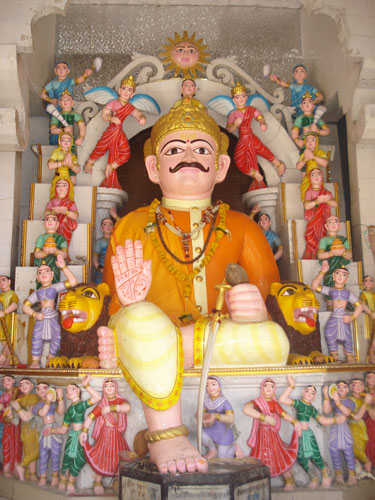





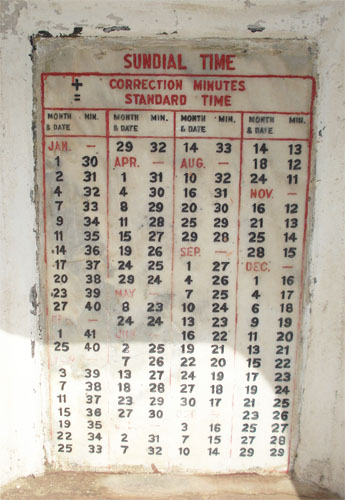



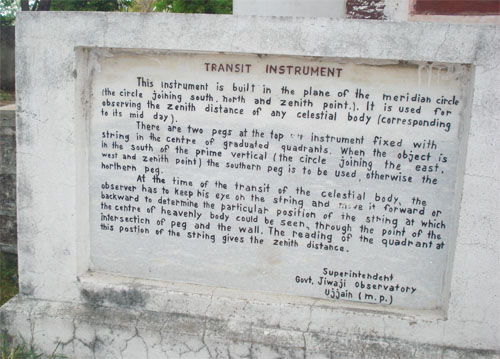



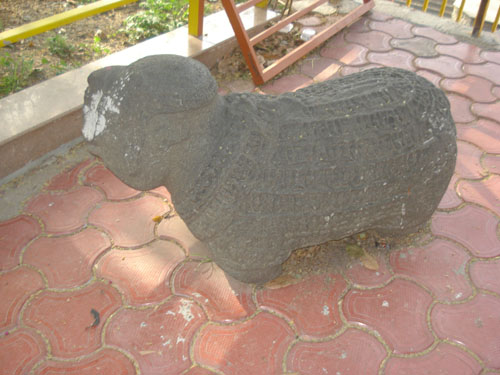




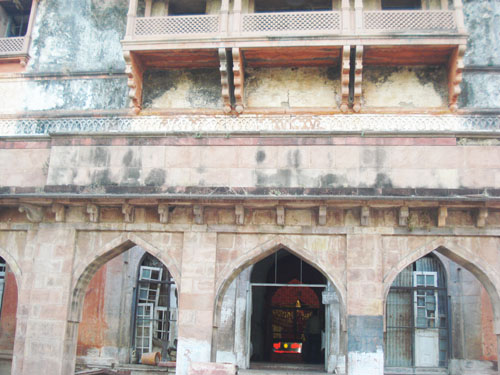
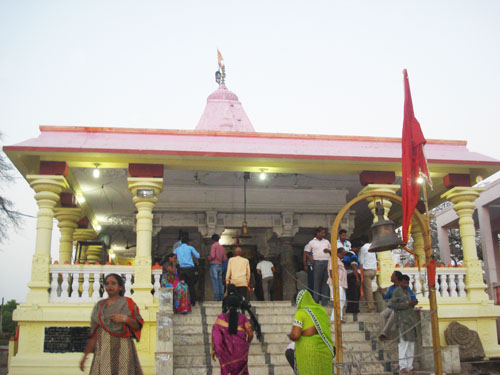


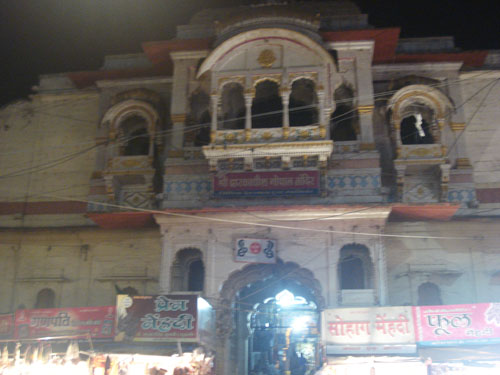



well written…thoroughly briefed !
your blogs are pretty good source of knowledge too !
thanks
LikeLiked by 1 person
Hi AYJ 🙂 Thanks so much for visiting my blog and for your kind comments 🙂 Keep visiting for some more interesting stuff 🙂 Best.
LikeLiked by 1 person
Isn’t it incredible the wonders of such architectural beauty? Enjoyed reading the post and the legend surrounding them. Quite surprisingly, I stumbled here on Maha Shivratree celebration. Amazing work, Swarupa.
LikeLiked by 1 person
Hi Vishal, Thanks so much 🙂 Really wonderful that you reached my blog today. And glad to know that you enjoyed the visit. Do keep visiting for more interesting stuff. Cheers 🙂
LikeLike
http://kaalsarpshanti.com
Kaal Sarp Dosh or yog is a serious condition in one’s horoscope. As per Hindu astrology, when all the seven planets are hemmed between the shadow planets Rahu and Ketu, Kaal Sarp Yog is formed. Rahu is the serpent’s head while Ketu is the serpent’s tail. The presence of Kaal Sarp Yog in one’s horoscope is very harmful. It harms every aspect of the individual’s life.
LikeLiked by 1 person
Hi Acharya 🙂 Thanks for visiting and for sharing the info. Best 🙂
LikeLike
These posts on Indore, Ujjain and Maheshwar are extremely helpful now that we are planning a trip there this week!! Thank you so much!!
LikeLiked by 1 person
Hi Anusha 🙂 Thanks, Glad to know that my blog has helped in your trip planning 😀 Happy Travels, Best 🙂
LikeLike
Mahakaal ki jai ho
LikeLiked by 1 person
Thank you for an amazing article. So very informative. I look forward tovisiting Ujjain in July or August. Best wishes
LikeLiked by 1 person
Hi Karen 🙂 Thanks so much! Have a gr8 time in Ujjain 🙂 Happy travels and do keep visiting me 🙂 Best.
LikeLike
Amazingly written and very useful too!
Thank you so much!!
I scheduled my ujjain trip by reading ur blog. I could choose well for my half day trip based on the info you provided!!!
Thanks again!!!!
LikeLiked by 1 person
Hi Ramakrishna, Thanks so very much 😀 Keep visiting my blog and happy travels! Best 😀
LikeLike
What an amazing blog! Came in handy for a newsletter article I’m writing. Thank you!
LikeLiked by 1 person
Hi Rohan, Thank you for visiting my blog and for your kind comments 🙂 Keep visiting!
Cheers 🙂
LikeLike